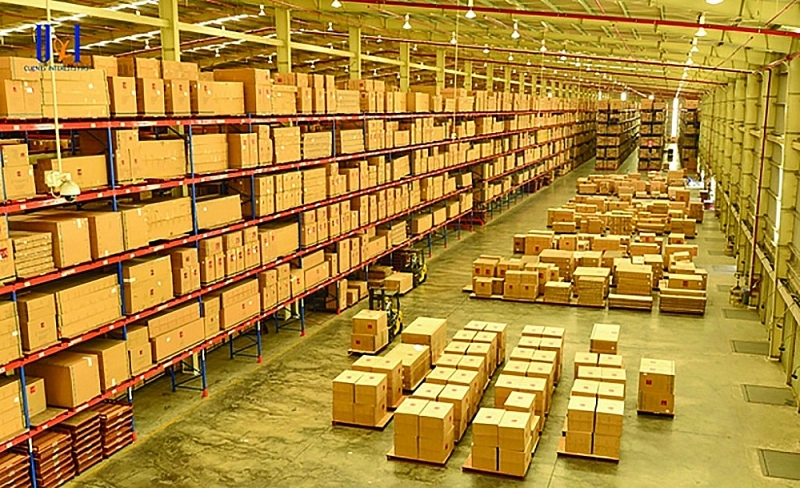 |
| U&I Logistics bonded warehouse |
Take advantage of potential
| Curently, countries tend to apply green standards to imported and exported goods. Therefore, in the logistics industry, “going green” has become a mandatory requirement for businesses to be able to participate in the supply chains of global manufacturers and suppliers. |
Deputy Director of the Import-Export Department (Ministry of Industry and Trade) Tran Thanh Hai said that in recent years, Vietnam’s logistics industry has made significant progress with an average speed of 14 – 16% per year, with a scale of 40% per year – 42 billion USD/year. The number of businesses and the quality of logistics services are increasing.
However, Vietnam’s logistics industry still reveals many weaknesses such as high logistics costs; lack of connection between logistics service businesses and manufacturing, trading, import-export businesses. Moreover, the scale and financial potential of Vietnamese logistics enterprises are still weak, and their progress into foreign markets is not significant…
According to the leader of the Import-Export Department, currently, Vietnam is exposed to many opportunities to promote the development of the logistics service industry. Specifically, the road traffic infrastructure system, airports, seaports, warehouses, commercial infrastructure, and logistics centers are constantly expanding on a large scale and widely.
Recently, Vietnam has witnessed a boom in e-commerce and logistics for e-commerce. In 2023, the scale of Vietnam’s retail e-commerce market reached 20.5 billion USD, an increase of about 4 billion USD (equivalent to 25%) compared to 2022. With that result, Vietnam is ranked in the top leading e-commerce growth rate. Changes in geopolitics, society, economics, trade and especially technology are factors that push Vietnam’s logistics industry to improve its service delivery methods to become more professional and effective.
Mr. Tran Thanh Hai said that, as one of the key industries, logistics needs to be carefully invested in to be able to respond and adapt to the market context, and provide maximum support to promote the development of other industries. Technology application in logistics and e-commerce are useful because it can optimize the efficiency of the activities of these two industries; therefore, it enables to reduce logistics costs for the entire economy and realize a key goal of any country, especially for Vietnam where logistics costs still account for a high proportion.
In addition, technology application helps improve service quality, increase customer experience, reduce carbon emissions, and packaging waste that pollutes the environment by optimizing transportation routes and well controlling delivery based on technology applications and artificial intelligence. These benefits not only bring value to each business from an economic perspective and service quality, but also have a general impact on the entire logistics industry, e-commerce as well as the economy.
Applying technology to turn green
Many businesses have been gradually applying technology, reducing emissions and improving efficiency. Mr. Le Quang Trung, Deputy General Director of Vietnam Maritime Company (VIMC), said that competition to obtain orders in the logistics industry has become fiercer. In addition to competitive pressure on services, new international and domestic standards on the environment, traffic safety, and labor safety also put logistics service businesses in front of innovation requirements. Currently, many global logistics businesses that outsource services also require emission standards for third-party logistics businesses. That context requires logistics businesses to proactively invest and transform production and business models in a “green” direction.
Ms. Nguyen Thi Thu Ha, Deputy General Director of Vinatech Group Company, said that the storage solution industry is facing big challenges in optimizing space and improving storage performance. In that context, applying smart technology to warehouse management is an inevitable trend, helping businesses overcome space barriers and improve productivity.
Mr. Dinh Thanh Son, Deputy General Director of Viettel Post Corporation, besides advantages, Vietnamese logistics businesses face many challenges: Firstly, legal frameworks, policies and legal documents in the logistics industry have not been implemented in a detailed and consistent manner, causing ambiguity and sometimes conflicts in implementation. Second, transport and logistics infrastructure is not synchronized, does not create the necessary multimodal transport system, leading to limitations in transshipment of goods between modes of transport. Third, logistics enterprises, logistics enterprises still face difficulties in operating scale, investment capital, human resources, lack of experience and professionalism, causing difficulties in competing and provide efficient service. Finally, there is a lack of quality human resources: the majority of workers in domestic enterprises account for 93 – 95% but lack expertise, are not properly trained, and mainly participate at the level of small supply chains such as delivery, warehouse management and bill of lading processing…
Despite current challenges, businesses are exposed to many benefits in applying logistics automation such as: improving work efficiency; saving financial resources; responding quickly and flexibly.
Green logistics is not only a trend but also a responsibility. Therefore, according to Ms. Le Thi Hoai Thuong, Senior External Relations Manager, Nestlé Vietnam, promoting sustainable development and digital transformation is an inevitable trend that needs to be implemented throughout the value chain from upstream (operations, manufacturing, logistics) to the downstream supply chain.
A modern and smart supply chain is about more than just digital transformation. It is necessary to build a clear strategy and technology development roadmap, and develop staff capacity to adapt to the transformation, operate and maintain supply chain efficiency. “Emission reduction goals need to be prioritized in the transition process, especially in optimizing resources; converting, saving and using energy effectively”, Ms. Le Thi Hoai Thuong analyzed and said there also needs to be a consistent, long-term policy framework, along with the cooperation of many stakeholders. In addition, it is necessary to timely give out specific mechanisms and instructions to promote the use of green energy and develop means of transport using green energy in Vietnam.
